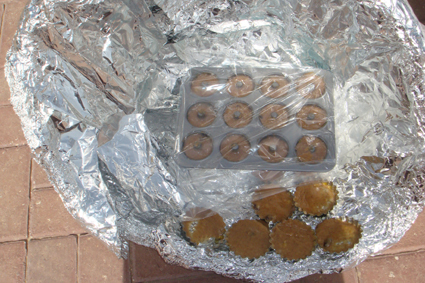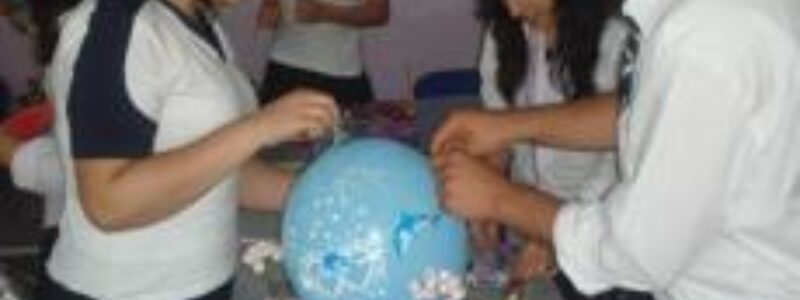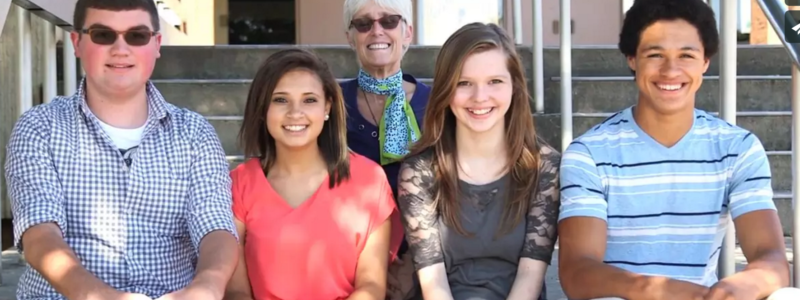Solar Cooker Project

This plan was designed to enhance iEARN's Solar Cooking Project, where students collaborate globally to improve health and reduce problems caused by fuel shortages.
Download a template (.pdf) showing how the Finding Solutions to Hunger project is aligned to the Common Core
Teacher Goals:
- One goal is to integrate some of the technology education standards into my science curriculum.
- Another goal is to give my students a hands-on real-life way to understand and learn about energy transfers.
- A third goal is to introduce my students to others from around the world and collaborate with them on this project, sharing recipes, designs, and results.
Student Goals:
- Students will work cooperatively in teams, sharing the work of research, development, and testing of solar cookers. This will be differentiated by learning style, since many modes of gathering information will be used, such as reading, video, diagrams, dialog and trial and error.
- Students will learn about radiation, conduction, and convection. They will also review energy transfers (electromagnetic to chemical).
- Students will use technology (cameras, video, and internet) effectively to communicate and share with other students around the world.
- Students will learn that radiation is the transfer of heat through empty space (as from the sun), conduction is the transfer of heat from direct contact (as from the surface of the cooker), and that convection is the transfer of heat through a current. They will also review the fact that energy can be transfered from one form to another, as from electromagnetic waves from the sun into thermal energy (heat) into chemical energy of the cooked food.
State Science Standards Addressed by This Project:
- Differentiate among radiation, conduction, and convection, the three mechanisms by which heat is transferred through the earth’s system.
Technology Standards:
- Given a design task, identify appropriate materials (e.g., wood, paper, plastic, aggregates, ceramics, metals, solvents, adhesives) based on specific properties and characteristics (e.g., strength, hardness, and flexibility).
- Identify and explain the steps of the engineering design process, i.e., identify the need or problem, research the problem, develop possible solutions, select the best possible solution(s), construct a prototype, test and evaluate, communicate the solution(s), and redesign.
- Demonstrate methods of representing solutions to a design problem, e.g., sketches, orthographic projections, multiview drawings.
- Identify appropriate materials, tools, and machines needed to construct a prototype of a given engineering design.
- Explain how such design features as size, shape, weight, function, and cost limitations would affect the construction of a given prototype.
Common Core State Standards
- RST 8.3 Follow precisely a multistep procedure when carrying out experiments or performing technical tasks.
- RST 8.4 Determine the meaning of key terms as they are used in a specific scientific context.
- WHST 8.2 Write informative/explanatory texts (narration of scientific procedures)
- WHST 8.7 Conduct short research projects to answer a question, drawing on several sources and generating additional related, focused questions that allow for multiple avenues of exploration.
- WHST 8.9 Draw evidence from informational texts to support analysis, reflection, and research.
Introducing the Project to Students:
I plan to present this project to my students by showing them the Get on the Net video and explaining the idea in class. I will send home the letter to parents, and have students sign a buddy contract. I will tie it into our curricular studies by relating it to our unit on heat transfer (conduction, convection, and radiation). It will also link to some technology standards that must be covered. I think the video will get them interested to begin with. Then I plan to do the class survey and welcome packs with other countries who are doing this solar cooker project if they would like to exchange that information. I think that will get them interested. And of course, the hands-on aspect of making the solar cookers will interest many students. My students will bring background knowledge of how to use the internet and email, some have video camera knowledge, some may have construction background skills, and they all have research skills.
Productivity of Work:
Will your students need to do research for their project?
Students will need to do research to find out various designs and materials to use for their solar cookers. They will also need to research recipes for when they are ready to cook something.
How will they be organized to gather information?
I will divide students up into groups of three or four. Groups will be mixed by gender and ability within their classes.
Who will be responsible and in charge?
I will be responsible for the overall project, in collaboration with another teacher whose students will be joining mine to do this project. Within groups, students will each have different responsibilities, such as timeline organizer, materials engineer, social/environmental researcher, food/recipe expert, and so on.
How you will handle the e-mail exchanges, how often, who will be in charge?
I will be responsible for sending and receiving the emails, but students will write many of them and edit them before I send them. I imagine that I could email twice a week, to give updates on our progress.
Conclusion of Activity
When does your participation end?
I plan to start this after our April vacation, beginning on April 26th. I would probably wrap it up by the 3rd or last week of May.
How will the students draw their projects to a conclusion?
Students will video tape and take pictures of their solar cookers in action. They will also type up their recipes onto cards and decorate them and laminate them for future use. We will send the pictures and video to our cooperating countries via the internet, and copies of the recipes via mail. We will also be sure to thank our cooperating students from around the world. Depending on what we receive from our partner students, we may present our collaborative work to the rest of our school in an assembly to encourage others to participate in iEARN projects, since we have a grant that will be paying for our entire school to be part of the iEARN community next year.
Identify technological and material requirements
Technological requirements
We will need to use the computers in the library to research solar cooker information. We will use the internet to send and receive emails and information from our partner schools. We will use our video cameras and digital cameras to record our progress and finished product.
Material requirement s
We will need envelopes and postage to mail our welcome packets to partner schools as well as our recipe cards at the end. We will need material to build the solar cookers (I am guessing lots of cardboard and aluminum foil). We will need storage space for the cookers while we are constructing them. I will need to make class sets of contracts, parent letters, instructions, rubrics, etc. to facilitate the project. I will also need to of course build in time for this project into our chapter where it fits, and work around MCAS testing, which is in May.







